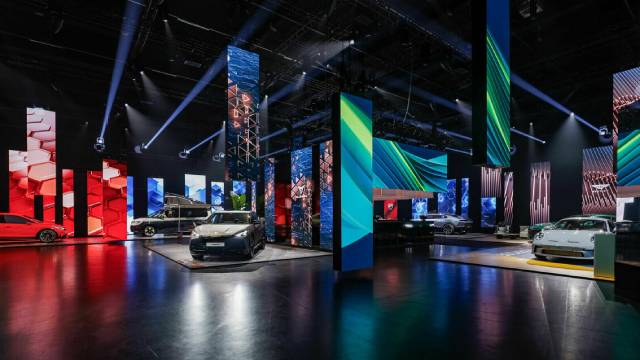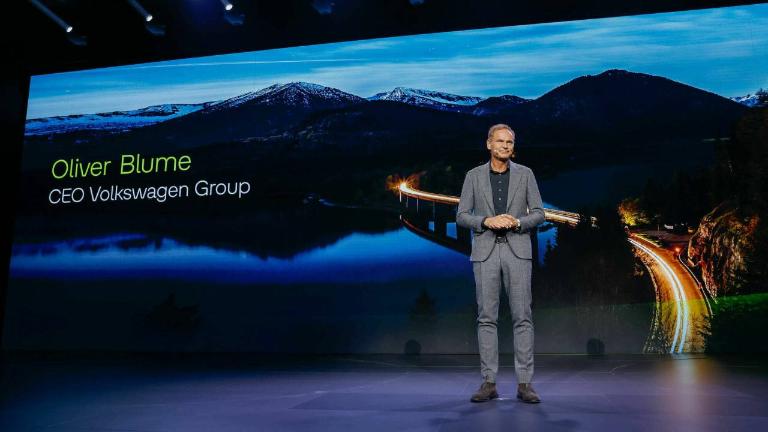E-mobility, design, software and new profit pools: the Volkswagen Group's vision
At the IAA Mobility in Munich, CEO Oliver Blume took stock of the Group's transformation path, with a focus on platform strategy and the importance of design.
A holistic approach to sustainable mobility, concretised through the platform strategy in four different areas - Architecture, Battery & Charging, Software and Mobility - and a renewed focus on design, a key distinguishing element not only for vehicles, but also for the digital experience. These were the topics addressed by Oliver Blume, CEO of the Volkswagen Group, at the IAA Mobility in Munich. "We are making good progress. And faster than planned. We have reached numerous milestones, set important strategic directions and achieved joint successes” said Blume. "We are systematically driving forward the transformation along our ten-point plan and consistently developing further attractive profit pools in the area of sustainable mobility".

Architecture: from MEB to PPE...
The mechatronic platforms for vehicles are an integral part of the Volkswagen Group's DNA. Expertise in this field distinguishes the Group from most other players in the industry, giving it a competitive advantage and significant scalability potential across the ten core brands. Since 2012, some 45 million vehicles have been built on MQB basis; with the MEB, the company was one of the first to transfer the concept to the electric era, and since its introduction in 2020, more than 1.1 million 100% electric vehicles have been delivered, across the Group's five brands, built on this platform. After Ford, Mahindra could also use some components of the MEB for its vehicles. The next steps? In 2024, the PPE (Premium Platform Electric), the second platform dedicated to zero-emission models, will be launched: jointly developed by Audi and Porsche, it will feature a powerful and efficient electric drive with a range of more than 600 kilometres, as well as an innovative battery management and charging system with 800-volt technology. Audi Q6 e-tron, unveiled at the IAA Mobility, is the first PPE-based car.
... to MEB+ and SSP
Then, the enhanced MEB+ platform will be introduced in 2025, with a further increase in range and efficiency of around 10 per cent. The new all-electric models of Volkswagen, Škoda and CUPRA with entry-level prices below 25,000 euro will be the first to use it. In the medium term, the Volkswagen Group will switch to the Scalable Systems Platform (SSP), which will be the only future platform and will integrate electric and electronic architecture. A solution that creates enormous potential in terms of standardisation and scalability: over 40 million vehicles, of all brands and segments, will be built on the SSP.
Battery & Charging
Unlike many competitors, the Volkswagen Group has chosen to integrate the development and production of battery cells into its value chain with PowerCo, the Group’s battery company. The aim is to keep a significant part of the value creation of an all-electric vehicle in-house. Reducing battery costs is one of the keys to large-scale deployment of electric mobility; the key levers to achieve this, up to 50 per cent cheaper than the first generation MEB, are the unified cell developed by PowerCo, standardised gigafactories and further technological innovations such as the dry coating process and 'low cost' cell chemistry without cobalt and nickel.

Software
A further priority of the Volkswagen Group is the constant expansion of its competencies, with the aim of being a benchmark in terms of user experience and satisfying customers worldwide. The approach, in this case, revolves around three fundamental elements: targeted development, strategic partnerships and efficient licensing.
With the Audi Q6 e-tron the new E³ 1.2 software generation will also make its debut. In the near future it will be the turn of the E³ 2.0 software architecture; for this, CARIAD - the software company of the Volkswagen Group - will accelerate the entire development process by simplifying the project organisation and reducing complexity through streamlined processes and clearly defined responsibilities. Operations at the Software Defined Vehicle Hub (SDV), in which employees from CARIAD, Volkswagen and Audi will jointly develop vehicles with a completely software-centred vision, will start shortly.
Mobility
The fourth pillar of the Group's strategy is the platform dedicated to mobility services. Created together with Europcar, it will cover all mobility needs - from hourly to long-term rental offers - and will also integrate third-party services, such as e-scooters and public transport, in one app. The pilot project in Vienna was successful; at a later stage the platform will be introduced in Germany and Europe.
The profit pool related to mobility services is growing rapidly; forecasts project the size of the global market to be in the order of EUR 100 billion in 2030. And the planned investment by Volkswagen Financial Services in Bike Mobility Services (BMS), a subsidiary of Pon, a long-standing Dutch partner and the world's leading bicycle manufacturer, should also be interpreted in this light. Many companies are expanding their employee mobility services to include bicycles as an extension of the traditional company fleet; the Group intends to significantly expand its bicycle leasing business worldwide, with a focus on Europe and the United States.

The importance of design
Identity, consistency and innovation: these are the concepts to be conveyed through design, one of the most important differentiating factors between brands. And this not only applies to vehicle exteriors and interiors, but also to the digital experience. Therefore, the Volkswagen Group will place even more emphasis on this aspect. Oliver Blume also emphasised the importance of design in creating an emotional connection with customers: 'Design is one of the factors that determine the success of our Brands; each of them has its own personality. The Group's design principles aim for quality and greater brand differentiation, and the strategy in this area is based on the further development of established model series, technological lighthouse projects for electric vehicles and iconic products of the Volkswagen Group.
VGI | Responsible OU: VP | Creation date: article date | Class 9.1
